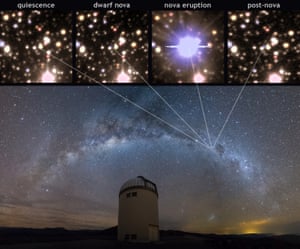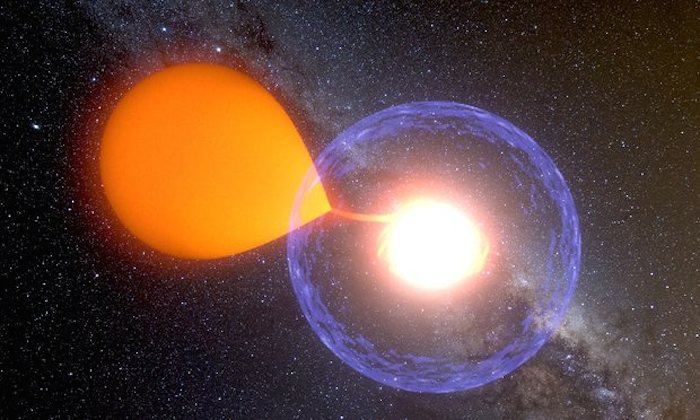Astronomers have monitored a nova – a sudden eruption of brightness – in an anonymous star 23,000 light years away, and used their observations to add weight to a theory of heavenly happenings.
The nova, a white dwarf in a star system known only as V1213 Cen, in the southern sky in the direction of the constellation Centaurus, would have been visible only to observers with binoculars. It suddenly shone brightly and then dimmed in May 2009.
The scientists identified what they call Nova Centauri by combing data in a massive, sustained sky survey called OGLE, short for optical gravitational lensing experiment.
And, they report in Nature, the images revealed a classical nova: a white dwarf star that had been stealing mass from a dim companion. Although they have only a few years of observations, they think they have captured a key moment in a cycle of events than can last thousands to millions of years. The ultra-dense white dwarf star increasingly steals gaseous matter from its less substantial companion, to trigger a runaway thermonuclear reaction that turns into an explosion of luminosity before resuming a long, slow hibernation. The scientists identified a series of “bumps” in the data before the eruption of brightness, followed by a slow falling away of luminosity that fitted all their predictions.

Seven years after the observation, Nova Centauri is still 50 times brighter than before, but fading. It will go on getting fainter and fainter until, many centuries from now, the cycle begins again.
Five to 10 such events are observed in the galaxy every year, and novae have a central place in the history of science. The prevailing cosmology 450 years ago painted an imperfect, constantly-changing Earth at the centre of creation, observed by unchanging heavens. And then in 1572, the Danish astronomer Tycho Brahe observed what he reported as De stella nova, a new star where there had once been no star, and brighter than Venus. It was a starting gun for a scientific revolution that gathered pace in the next century with Galileo, and Newton. Tycho’s star is thought to have featured in the first act of Shakespeare’s Hamlet with a reference on the ramparts of Elsinore to “... yond same star that’s westward from the pole.”
Astronomers now think Tycho saw something much more violent, called a supernova. But ever since, astronomers have been puzzling over the mechanics of the nova phenomenon, and the hibernation hypothesis is one explanation.
“I would say it is the best hypothesis we have. It is somewhat controversial, but no one has proposed anything equally good,” said Przemek Mróz of the Warsaw University Observatory in Poland, who led the study.
“We’re not saying that our observations ‘confirm’ a hibernation scenario, rather ‘they are in accord with hibernation predictions’. The most important point is that before the 2009 eruption our system was really faint and the mass-transfer rate was low and unstable - this is why we observed small ‘bumps’ in the light curve of our object.”
The OGLE project monitors the densest sky regions, the galactic centre and the disc of the Milky Way. It has already identified 20 extrasolar planets and delivered an explanation of another kind of nova, based on the merger of two stars. The survey monitors more than a billion stars each night.
Quelle: theguardian

